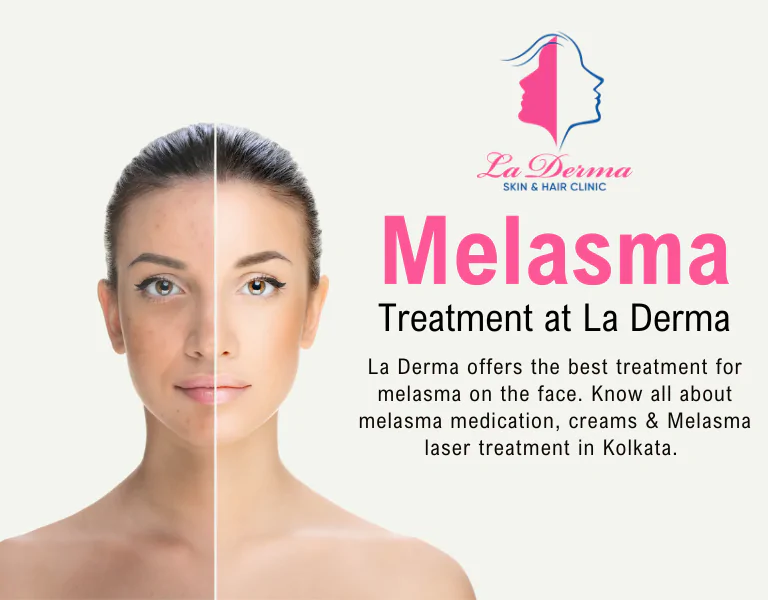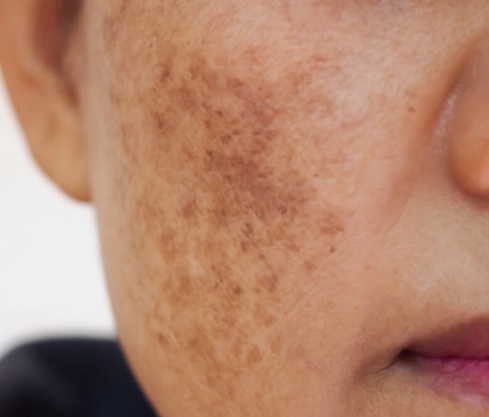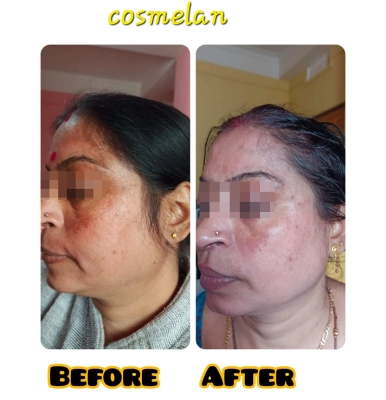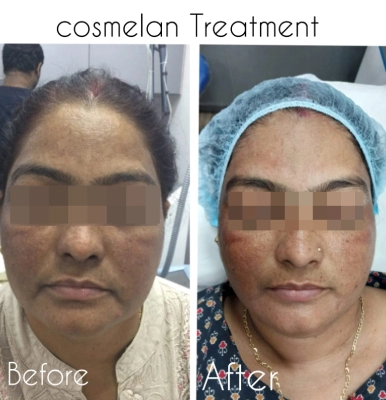Where is Melasma Typically Found?
Melasma most often appears on the face, specifically on:
- Cheeks
- Forehead
- Bridge of the nose
- Chin
- Besides the face, it seldom affects the exposed skin of the forearms, neck, and back.
Signs And Symptoms Of Melasma
Melasma causes darker patches on the face, usually on cheeks, forehead, or upper lip. These patches are typically symmetrical and brown or greyish. Sun exposure makes them worse. Melasma is more common in women with darker skin tones. While harmless, it can affect self-esteem.
What Causes Melasma?
Melasma causes include:
- Hormonal changes (pregnancy, birth control)
- Sun exposure
- Genetics (family history)
- Darker skin tones
- Certain cosmetics and medications
- Stress (possible)
How To Diagnose Melasma?
Melasma diagnosis is a two-pronged approach: gathering information and examining your skin.
Information Gathering:
- Your dermatologist will first discuss your medical history, including any recent changes in medications, birth control use, or pregnancies (especially relevant for women). They’ll also ask about your skincare routine and any past skin issues.
Skin Examination:
- A physical examination of your face is key. The dermatologist will look for telltale signs like brown or grayish patches, typically symmetrical on cheeks, forehead, or upper lip.
- They might use a Wood’s lamp, a special light that can reveal how deep the pigment goes within your skin layers. This helps determine the best treatment approach.
- In rare cases, a small skin sample (biopsy) might be needed for further analysis under a microscope to definitively rule out other conditions with similar symptoms.
Remember, a dermatologist’s expertise is crucial for an accurate diagnosis and personalized treatment plan for your specific melasma.
What Are the Options for Melasma Treatment?
Despite the array of advanced treatments available, the response of melasma to these treatments can vary. Achieving total and permanent relief from melasma remains elusive with any single treatment option.
At La Derma, our skin specialists tailor your treatment plan and advocate regular maintenance to minimize melasma and deter its recurrence. Your dermatologist may suggest a combination of the following treatments, tailored to your skin’s type, cause, and severity:
- Many topical medications like retinoids, vitamin C etc. in the form of cream , ointment , gels etc are used but they only have limited effect.
- CHEMICAL PEEL: Chemical peels are a type of skin treatment that involve applying a chemical solution to the skin to exfoliate and remove the top layers of damaged or discolored skin cells. Chemical peels can be effective in treating melasma by removing the damaged skin cells that contain excess pigment. This encourages the skin to shed the damaged cells, revealing the healthier, more evenly pigmented skin beneath.
It’s important to note that chemical peels should only be performed by a trained and experienced professional. Additionally, chemical peels may not be suitable for all skin types and conditions, so it’s always best to consult with a dermatologist before undergoing any treatment. - COSMELAN PEEL: The cosmelan® method is a unique treatment that utilizes a combination of active ingredients with proven efficacy. It offers both short- and long-term results due to its dual action. Although it is a peel, it goes beyond traditional peeling methods. While standard peels act on the skin’s surface by eliminating top layers and promoting renewal, the cosmelan® method not only visibly removes and reduces spots like a peel, but it also regulates the overproduction of pigmentation that causes spots, preventing them from reappearing. Unlike peelings that address only the surface of the problem, cosmelan® treatment targets the root cause.
- Q SWITCH LASER: Q-switched laser is a type of laser that delivers high-intensity, short-duration pulses of light to the skin, and it is often used in the treatment of hyperpigmentation, including melasma, dark spots, sun spots, and age spots. The Q-switched laser works by targeting the excess melanin in the skin that causes hyperpigmentation. When the laser light is absorbed by the melanin in the skin, it breaks down the excess pigment and causes the skin to shed the damaged cells over time.
One of the key advantages of Q-switched laser treatment for hyperpigmentation is that it can deliver highly targeted and precise treatment, with minimal damage to the surrounding skin. Additionally, it can be used on all skin types, including darker skin tones, and it is generally considered safe when performed under supervision of a qualified dermatologist as in La Derma. - CO2 LASER RESURFACING: The CO2 laser works by removing the damaged skin cells that contain excess pigment, and it also stimulates the production of collagen and elastin in the skin, which can improve skin texture and tone over time. The laser energy is delivered in a controlled manner to minimize damage to the surrounding tissue and reduce the risk of scarring or other complications.
- MICRODERMAABRASION: Microdermabrasion is an clinic procedure used to treat hyperpigmentation that affects the superficial layer of skin only (superficial scarring). During the procedure, your dermatologist will use a handheld tool with a wire brush or another abrasive attachment. It smoothen your skin tone.
MICRONEEDLING : This minimally invasive procedure creates microscopic tears in your skin. As the skin heals, it tends to have a more even skin tone. It is done with a Derma Pen and its almost painless. - GFC PRP Therapy/ Platelet Rich Plasma Treatment: This procedure involves taking a small amount of your blood, placing the blood in a tube with growth factor concentrate and then placing the tube into a machine that separates the blood into layers, and then injecting the layer of blood known as plasma into the skin with melasma , dark spots or hyperpigmentation. This is the best and most effective treatment for Melasma. Most melasma patients reports more than 80 percent improvement with GFC therapy.
- TRAXENEMIC ACID injections- They are found to be very effective in treating Melasma.
It’s important to note that preventing exposure to UV rays is crucial in laser melasma treatment in Kolkata, as even minor sun damage can exacerbate, trigger, or lead to recurrence. Using sun protection is mandatory with every treatment approach.
What Is The Cost Of Melasma Treatment At Kolkata?
The cost varies a little across centres and for different persons depending upon severity of problem and procedure chosen. The indicative prices for various hyperpigmentation /dark spots/melasma treatment procedures at La Derma is given below.
| Procedure | Indicative Price in ₹ |
|---|
| GFC THERAPY | Rs. 8,000 |
| Micro Needling | Rs. 5,000 |
| Micro derma Abrasion | Rs. 4,000 |
| Q Switch | Rs. 4,000 |
| Carbon Q switch | Rs. 5,000 |
| CO2 laser resurfacing | Rs. 5,000 |
| Cosmelan Peel Face | Rs. 40,000 |
How To Get Started?
Melasma Treatment in Kolkata: If you think you have melasma, then don’t wait any longer! Complete the Book Appointment form, and our customer care team will assist you in scheduling a consultation with our experienced dermatologists. Alternatively, you can reach us by phone at +919433166666 to book an appointment at your preferred time, date, and location.








